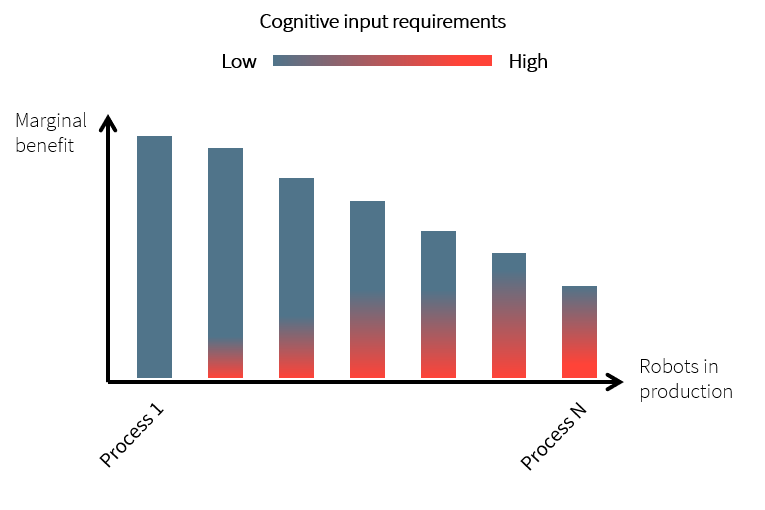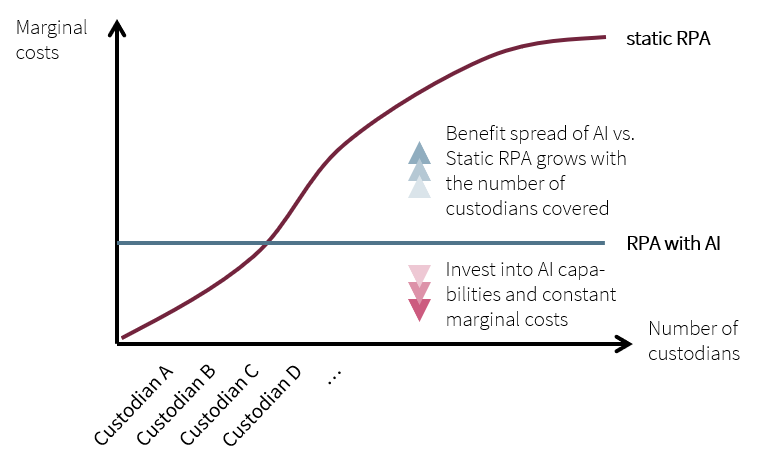RPA: proven track record for fast-paced, rule-based automation
Robotic process automation (RPA) is a reliable and straightforward technology that allows the rule-based automation of business processes across any application. The fact that it’s non-invasive and can be quickly implemented in any IT architecture makes it very attractive in terms of costs and benefits and time to market.
At its core, automation with traditional RPA involves translating business requirements into a pre-defined rule set for processing structured data. The outcome is always binary: either a condition is met or it isn’t (static). There’s no gray area with RPA.
Limitations of rule-based automation
Unfortunately, for RPA, we have come across many business processes where the binary outcomes didn’t fully materialise and a decision for a less favorable outcome, a lower automation rate, had to be made. A good example is KYC queries. The results presented to the compliance officer are rarely clear-cut black or white, but mostly a gray area. Depending on the maturity of your RPA journey, this trend may be grounds for concern. With the increasing adoption of RPA automation, the use cases are tending to become more challenging, as the example below illustrates. As processes get more complex, the agility of RPA evaporates up to a point where putting the human back in the loop may be the only solution.

AI-powered understanding instead of decision trees
The lack of cognitive skills for RPA automation in rule-based robots can be overcome with the help of artificial intelligence (AI). AI add-ons for RPA draw on prediction-based models, which allow the robot to act based on a likelihood, thereby eliminating the need to program alternative complex and static decision trees.
Following a training phase (or an initial big data basis to train the algorithm), AI can support robotics in use cases ranging from invoice processing with digitised or scanned invoices and instructions to the context-based output of unstructured text (e.g., a full-text email such as a complaint, general inquiry, etc.). This essentially allows robots to understand data that would otherwise not be used without manual intervention or classification.
A further advantage of prediction-based models is that, under the right circumstances, they get better with time whereas rule-based RPA is static. In the case of invoice processing, for instance, it could mean that future suppliers are automatically recognised and processed.

Does an investment in cognitive skills pay off?
AI modules impact the RPA business case in terms of development costs and maintenance. The benefit can be showcased using a real-life process example.
In private banking, onboarding a new client requires the transfer of the client’s existing portfolio of assets. For this purpose, the old custodian bank issues so-called transfer instructions for the client’s portfolio. While the content of these instructions is standardised (security name, ISIN, quantity, and settlement instructions), the layout is not, meaning that the structure of the documents varies from bank to bank.
On the recipient bank’s side, this information is delivered by email and needs to be captured manually (or by a robot) in the core banking system. Without AI, an immense RPA decision tree would be required for each counterparty instruction layout, which is costly to develop and maintain. With AI, on the other hand, we can swap the decision tree for a prediction-based model that allows robots to understand the instructions and derive the required information.
The AI training of the model is both less sensitive to layout changes over time and cheaper than modeling a traditional RPA decision tree. This translates into increased benefits derived from less development time upfront and reduced maintenance.

Being smart pays off
To maintain its position as a trusted agile automation tool, RPA will have to become smarter. In combination with AI, RPA achieves just that: unstructured data can be processed, extending the automation spectrum to processes or parts of processes previously out of reach.
Moreover, intelligent automation with AI is more resilient, and requires less maintenance over time owing to the learning capabilities of the AI models embedded in it.
In conclusion, adding AI to RPA allows you to automate more in terms of scope and achieve better quality and stability over time.
Interested in RPA and AI? See our application on the security transfer use case!

